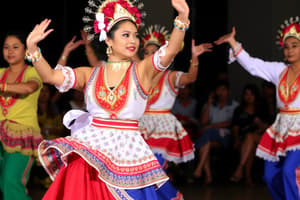Podcast
Questions and Answers
What is the main characteristic of folk dance?
What is the main characteristic of folk dance?
- It is competitive
- It reflects the life of people in a specific country or region (correct)
- It is a religious dance
- It is governed by an institution
Which terms are used to emphasize the cultural roots of the dance?
Which terms are used to emphasize the cultural roots of the dance?
- Classic and timeless
- Ethnic and traditional (correct)
- Modern and contemporary
- Popular and mainstream
Which type of dance is not considered a folk dance?
Which type of dance is not considered a folk dance?
- Hip hop dances
- Contemporary dances
- Ballroom dances
- Ritual dances (correct)
What is the main difference between folk dances and other types of dances?
What is the main difference between folk dances and other types of dances?
Which dance is not an example of European folk dance?
Which dance is not an example of European folk dance?
What are international folk dance groups?
What are international folk dance groups?
What are Balfolk events?
What are Balfolk events?
Which region has its own unique folk dances such as tamang selo, lion dance, and fan dance?
Which region has its own unique folk dances such as tamang selo, lion dance, and fan dance?
Which dance is not an example of South American folk dance?
Which dance is not an example of South American folk dance?
Flashcards
What is the main characteristic of folk dance?
What is the main characteristic of folk dance?
Folk dances reflect the everyday life, customs, and traditions of a particular region or culture.
Which terms are used to emphasize the cultural roots of the dance?
Which terms are used to emphasize the cultural roots of the dance?
These terms highlight the cultural origins and unique traditions associated with folk dances.
Which type of dance is not considered a folk dance?
Which type of dance is not considered a folk dance?
Ritual dances are performed for religious or ceremonial purposes.
What is the main difference between folk dances and other types of dances?
What is the main difference between folk dances and other types of dances?
Signup and view all the flashcards
Which dance is not an example of European folk dance?
Which dance is not an example of European folk dance?
Signup and view all the flashcards
What are international folk dance groups?
What are international folk dance groups?
Signup and view all the flashcards
What are Balfolk events?
What are Balfolk events?
Signup and view all the flashcards
Which region has its own unique folk dances such as tamang selo, lion dance, and fan dance?
Which region has its own unique folk dances such as tamang selo, lion dance, and fan dance?
Signup and view all the flashcards
Which dance is not an example of South American folk dance?
Which dance is not an example of South American folk dance?
Signup and view all the flashcards
Study Notes
Folk Dance: A Summary
- Folk dance reflects the life of people in a specific country or region.
- Ritual dances, such as religious dances, are not considered folk dances.
- The terms "ethnic" and "traditional" are used to emphasize the cultural roots of the dance.
- Folk dances are often ethnic dances.
- Folk dances are not governed by any institution and are not competitive.
- European folk dances include sword dances, Scottish highland dance, and modern western square dance.
- Certain folk dances are shared by several countries, such as some Serbian, Bulgarian, and Croatian dances.
- International folk dance groups exist in many countries and allow dancers to learn folk dances from various cultures.
- Balfolk events are social dance events in Western and Central Europe.
- East and Southeast Asian countries have their own unique folk dances such as tamang selo in Nepal, the lion dance in China, and the fan dance in Korea.
- South American folk dances include the tango in Argentina, the marinera in Peru, and the joropo in Venezuela.
- African folk dances include the kizomba in Angola, the bikutsi in Cameroon, the azonto in Ghana, and the takamba in Niger.
Studying That Suits You
Use AI to generate personalized quizzes and flashcards to suit your learning preferences.




